Cards for Environmental Healing
Click For Instructions
- 1) To Begin, click "Shuffle" to mix the cards while thinking about your question. Click the shuffle button as many times as you like until you feel your energy has made a connection.
- 2) Clear your mind and open your heart to receive an answer.
- 3) Chose a card by clicking on it.
- 4) Read the card.
- 5) It is best to not ask the same question over and over. However if you would like to ask a new, one card question, follow the directions on the pop-up window, after you get your first reading.
Longer readings with the unique card spreads designed by Microbe Whisperer can be obtained by going to the "Contact Me" page and submitting your request by email. The science learning tool can be accessed by clicking here.
Nitrosopumilus martimus (Ammonia to Nitrite)TUBES
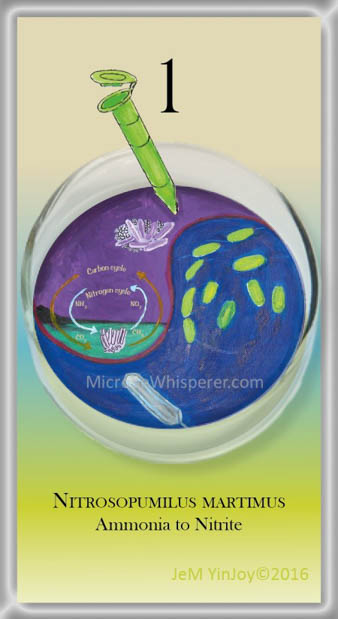
You have picked the ancient bacterium N. martimus.
This microbe can scavenge nanogram quantities of ammonia, which is an amount as scant as a sea horse’s breath, from the millions of gallons of water in the sea.
By its own example of feeding millions of sea creatures with its ability to convert ammonia to nitrate, this microbial animal guide brings advice on: Feeding the poor, working for the common good; wisdom combined with innovation; keeping secrets until death, comfortable with emotions, even in the cold, and surviving on very little.
Oceanospirillum (Oil-Eating Bacteria)TUBES
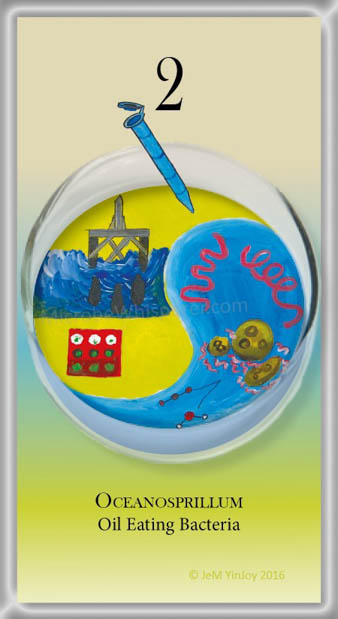
You have picked Oceanospirillum, a microbe who surfaced to fame after major spill crisis brought its oil eating talents into focus. This microbe teaches that when the terrorist plot manifests, when the bomb, or crash or other game-changing event overflows into our regular lives, we are called upon to dig deep into our inner resources, for powerful, latent, abilities that, we did not recognize for what they were, until it is time to turn the tide. Oceanospirillum prompts us to remember we have what it takes to remove the danger, to chew up the obstacles that are impeding others.
This microbe teaches that when emotional waters have become too murky and oily, our subconscious must awaken from its deep blue slumber and swim up to meet the challenge and allow our gifts to cleanse the environment, so that others may survive.
H. japonica (Triangular bacteria)TUBES
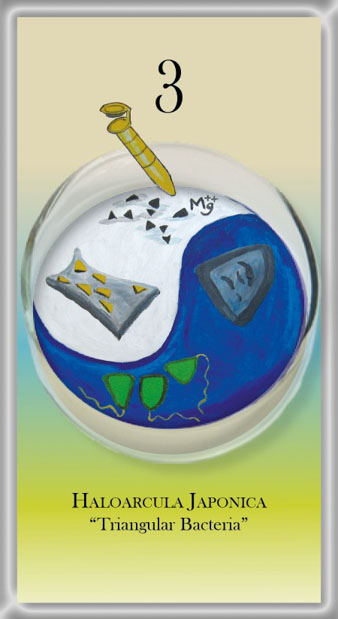
You picked H. japonica, a triangle-shaped bacterium that makes a protein found also in the human retina. This is suggestive of the mystical symbol of the “Eye in the Triangle”. This protein is used by an ancient category of bacteria the archeabacteria, to harvest light.
This third eye is believed to be a remnant from a more spiritually sophisticated form of human that lived on earth during an antediluvian “Golden Age.” Perhaps H. japonica harbors within its envelope, in organic form, the secrets of the ancients who knew how to harvest light from the sun, and transform it to insight, with their third eyes. This bacterium lives in a very highly concentrated salt environment. It teaches us the lessons of thriving under pressure, being physically adaptable, considering three sides to a problem, and unlocking mystical secrets.
H. Walsbyi (Square bacteria)TUBES
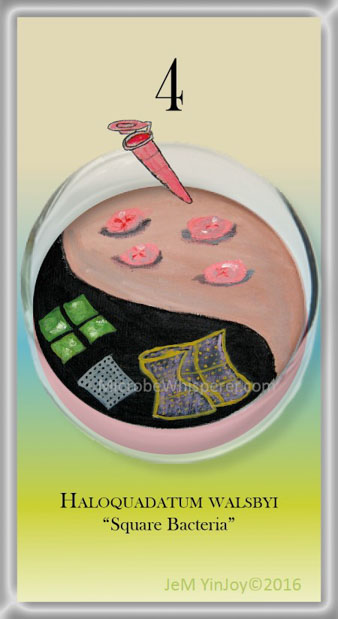
You have picked H. Walsbyi, a square-shaped microbe, that lives in high-salt environments, with a super thin body, and “postage stamp-like” sheets, making it a bacterial trend setter who has redefined the ultimate in resourcefulness. H. Walsbyi contain gas bubbles that allow it to float atop the saltiness, spreading itself out thinly, flatly, to make the most use of the water, with the buoyancy also helping it to be as close as possible to the surface of the brine ponds to harvest light from the sun. Usually we think of the phrase of “spreading yourself too thin” as a negative situation, where someone is over worked and has no time to relax. But H. Walsbyi establishes a unique alternative to the usual, since its interpretation of this phrase conveys clever use of a situation to survive, where others are “salted out” of competing with it.
Shape-shifted to adapt to its environment as no other microbe can, mysterious hints of how it uses light energy, and buoyantly floating on a rapidly shifting medium through it all, H. Walsbyi teaches us that sometimes going against tradition can result in a solid, square, base of security.
Pseudomonas putida (Landmine Detector)TUBES

You picked P. putida, the “Green Man” of the bacterial world. P. putida helps to protect plants from fungal infections- first as seedlings and later, as full grown plants. P. putida also has something in common with the great spiritual teacher Mother Teresa and the “Queen of Hearts,” Princess Diana of Wales, in that, with its red fluorescence pinpointing TNT in soil, P. putida has joined the efforts of these two stellar humanitarian women to protect innocent children from death or disfigurement due to dangerous landmines. With its penchant for housing an apothecary of degrading enzymes in its diverse plasmid genes, P. putida teaches the secret of having multiple arms, multiple talents, multiple faces, the ability to stomach toxins and purify them, being a protector of innocent children and new seeds, and a highly diverse diet.
Spirochaeta Americana (Mono Lake Bacteria)TUBES
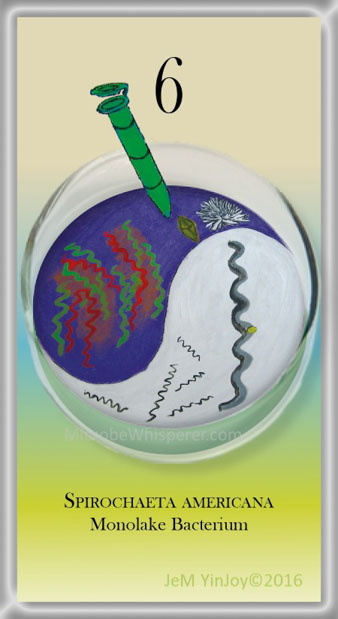
You picked the elegant S. americana. Delicate and sinuous within a cosy petri dish, but S. American can slither with merry courage witin the corrosives-laden Mono lake, winding through the interstices of submerged tufa, oblivious to the strongly basic solution that destroys most other living tissue. Just like a modern day woman who has remade herself, in spite of her harsh upbringing, the delicacy of its wall, and its elegance in movement are deceptive to those who do not understand S. americana and who do not realize the harsh realities with which it was raised
- americana has been hypothesized to have extraterrestrial cousins on Mars. that
By its spiral shape, S. americana teaches us of the sacred spiral of life, that directs us to the constant cycle of life lessons that return to us over and over, until we are able deal with them effectively with the increased wisdom we have gained. This microbial guide leads us on the increasingly clearer path, twisting us upward towards the universe and enlightenment.
Pseudovibrio Axinellae (Irish Marine Sponge)TUBES
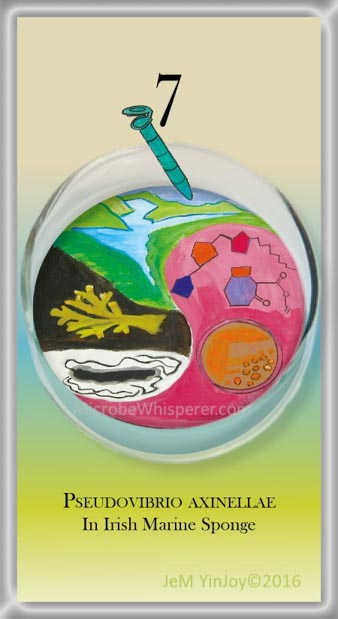
You picked P. axinellae who resides in an Irish sea sponge, as a symbiont. P. axinellae has evolved for centuries with its sponge host and so is resistant to the sponge’s natural antimicrobial protections.
The fact that P. axinellae makes antibiotics that most microbes have never seen, teaches us that necessity is the mother of invention. Due to its unique environment, P. axinellae creates avant-garde designer antibiotics.
axinellae teaches us that if we are true to our own, unique ingenuity, some of our creations could transition from being a local-artist’s phenomenon to highly a coveted gem with world-wide benefits.
Without hawking its wares, P. axinellae and its antibiotic art-work was discovered when it was needed most, which teaches you to believe your creations will be recognized by the right people, not just as art-work, but as useful medicine that will save lives all over the planet.
Spirulina (Edible Bacteria)TUBES

You picked Spirulina, known to the Aztecs, as a source of food that provided numerous health benefits. But without the tools of modern science. How did they do that? The ancients were masters of “waking the spirit” of an organism. The microbe teaches that we all have the ability to become attuned, as one organism to another, to listen to what plants, and microbes such as Spirulina, have to offer as gifts to the people of earth. Spirulina teaches these lessons:
Feeding the hungry, Harvesting sunlight for tremendous healing, Abundance in waters (emotions), Attunement to gifts from other species, Power to transform appearance and Mysterious movement
Chlamydomonas nivalis (Watermelon Snow)TUBES
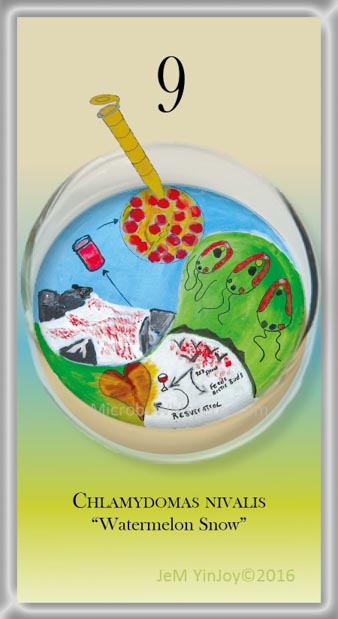
You have picked C. nivalis, the microbe that creates red snow. These cells bring energy and hope for survival to the many arctic creatures that depend on feeding off this microbe, when winter has chilled out or covered up other sources of nourishment. C. nivalis provides a bright message to the creatures flying or flitting or buzzing about the snow-covered slopes of the mountains where C. nivalis is simply producing red pigments for its own photosynthetic activities. The cells of C. nivalis imbue ice crystals so brightly with its red pigment that the tinted is evocative of watermelon fruit flesh, or a red snow cone. C. nivalis reminds us to be grateful for our curious minds that seek to tease out the reason for something not yet understood. C. nivalis also teaches us that if we have something to offer our world, do not be afraid to show everyone what you’ve got, in the loudest, brightest most attractive way you can muster.
Thiomargarita Nambiensis (Sulfur Pearl)TUBES
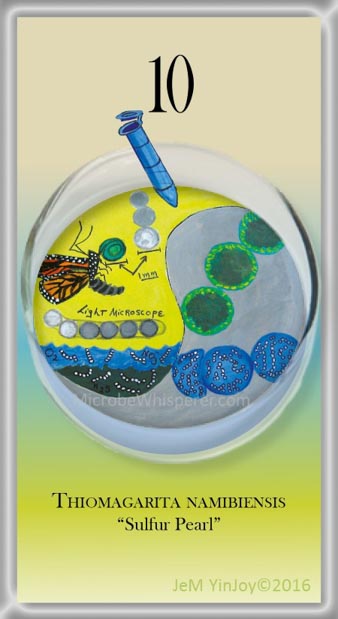
You picked Thiomargarita namibiensis, a giantess among the bacteria, who not only drapes herself in strings of opalescent pearls, but also doesn’t let go of her progeny easily. She prefers to hold hands with her daughter cells, forming strands of her identical offspring, in a formation that reflects her jewelry.
She survives on hydrogen sulfide and nitrate and she is rotund and very large, with no ability to move to acquire her food. T. namibiensis applies unique way to overcome her innate immobility. She simply came up with special compartments to store food.
T. namibiensis teaches us that it is possible to overcome personal shortcomings, and still find a way to survive under limited circumstances. T. margarita not only surmounts obstacles of scarcity by refashioning her own body to fit the need, but she is beauteous and bright while doing so. T. namibiensis does have the talent of ridding the sea floor of foul smelling hydrogen sulfide, so she teaches another lesson – Holding your breath while cleaning up odorous crevices, and making something shiny, bright and beautiful from the gunk.
Primoridial Cyanobacteria (Ancient Earth Oxygenators)TUBES

You picked Cyanobacteria which were responsible for the introduction of oxygen in Mother Earth’s atmosphere allowed the air-breathers to out-compete the ancient life forms that relied on an anaerobic earth atmosphere to survive.
What an enormous accomplishment this was! Cyanobacteria teach us that the power of the smallest action, or word, can have a globally transformative effect. Cyanobacteria teach that you can be the little powerhouse behind the big corporation or endeavor, because you alone possess the magical combination of “enzymes” that can generate the “oxygen” needed for the rest of the organization to thrive.
Cyanobacteria teach us to apply the wisdom of the ancient ones. Our current society stands upon the shoulders of the wise healers who came before. It is vital for our own progress, to learn their wisdom and see how it can be rehoned to solve the problems of the modern era.
Caminibacter mediatlanticus (Deep Sea Dweller)PETRI
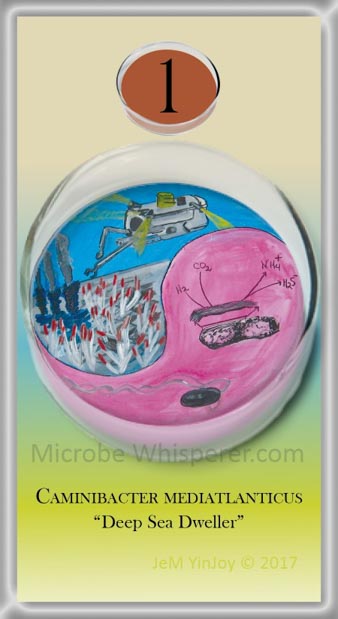
You picked Caminibacter mediatlanticus, a microbe found in deep-sea hydrothermal vents on the Mid-Atlantic Ridge, which is how it got its name as: medius for middle and atlanticus for Atlantic.
C. mediatlanticus, like an underwater alchemist, creates life from dissolved rock minerals. Without the benefit of sunlight, C. mediatlanticus metabolizes nitrogen and sulfur to make nutrients – food that supports a population of tube worms, shrimp and other creatures. With its ability to live without sunlight, C. mediatlanticus could make a home on the active moons of Neptune or the ancient seas of Mars, just comfortably as it has done so within the bubbling black smoker vents of the mid-Atlantic ridge on Earth. C. mediatlanticus lives in an environment without oxygen, without light and inside a searing-hot geothermal chimney. This one tiny teacher teaches the lessons of extreme survival. Without the comforts of the usual earth dwellers, who luxuriate under our sun and inhale life giving oxygen from photosynthesizers, C. mediatlanticus has forged an alternate lifestyle within the superheated undersea environment where it was found.
Thioautotroph Bacteria (Tube Worm Symbionts)PETRI
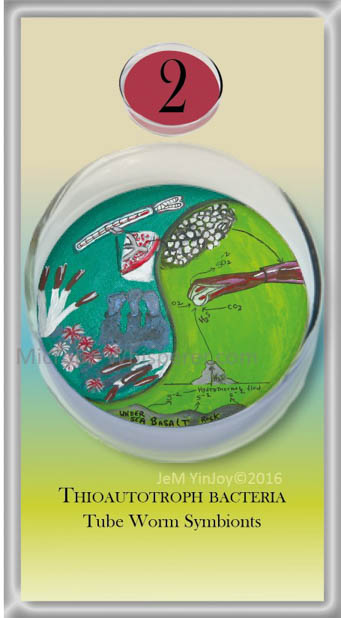
You picked Thioautotrophs, which are intracellular sulfur-oxidizing bacteria that are the primary producers of carbon for the adult tubeworm, called Riftia, which completely depends on these symbionts for its nutrition. Riftia pachyptila have as part of their bodies, a unique morphological adaptation designed specifically to house bacterial endosymbionts. This adaptation is the trophosome where endosymbionts reside, having evolved alongside their hosts for millennia. So much evolution together was bound to create an inseparable bond. The host, in this case the tube worm Riftia has bent over backwards and sideways to modify its own physical appearance to accommodate its endosymbionts. The relationship between the endosymbiont and Riftia tubeworms suggests a deeply spiritual lesson, that we are all in a symbiotic relationship with all beings on this earth, and that this interdependency is the key to creating a joyful heaven within us.
Metabolic Groups (Winogradsky Column)PETRI
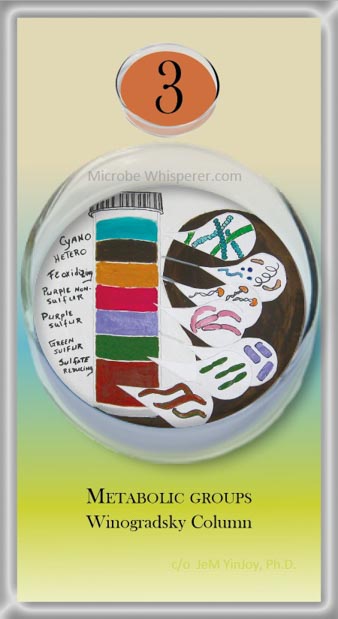
A Winogradsky column is a complete, self-contained recycling system, fueled by the energy that bacteria receive from each other’s metabolic activities, and light.
The success of a perfectly honed barter economy is taught, within the wonderful microbial community that grows in a Winogradsky column. Many human microcosms illustrate the same concept, what might be your neighbors’ excess, could nourish you and your family. What is not used can be passed further along the chain of people who can convert your disposed items into something useful for them. As of this writing, our global society still relies on money for the most part. The majority of us are not convinced that a barter economy is feasible, but that is just because not everyone is on board. Stick us all in a container like a Winogradsky column and see how quickly we either become cooperative and rely on each other for goods, or expire if we refuse to share in the venture.
The lessons taught are that we are here to share our abundance, and receive gifts from others who are of like mind and compassionate hearts.
Actinomyces (Glass Eating Bacteria)PETRI
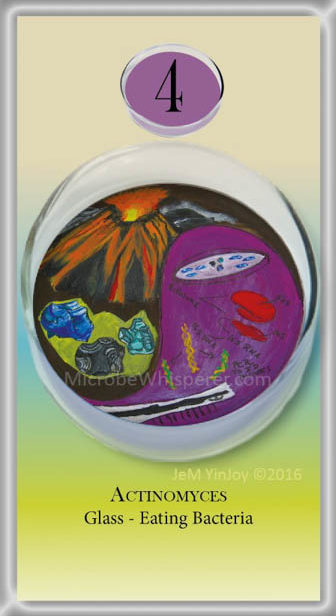
You picked Actinomyces bacteria, who can trace their lineage back millions of years and might have been the earliest bacteria to crawl out of the watery depths of young earth and on to the dry barren terrestrial environment. By virtue of their strong flexible bacterial walls, and their talent for spreading as micro-mycelia, they were able to withstand the dry land, better than their other bacterial sisters who still swam in the primordial soup. When those of us, especially the most hypersensitive and spiritually awake, find ourselves drowning in the sea of human misery, when the emotional mass of our world becomes so overwhelming, we find ways to leap out of it. The lesson of this microbe is to urge you to find a way to make that quantum leap, out of the roiling mass of primitive emotions, out of that soup of human despair.
If you do, you may discover a new set of skills to adapt to this sudden transition, that allow you to stay upon the surface of woes, not drown, but rather hone those skills and hold fast to your new land.
Sulfolobus Solfataricus (Biofuel Microbe)PETRI

You picked Sulfolobus solfataricus is a sulfur-oxidizing thermophilic microbe, which grows in hot, acidic environments. In other words, Sulfolobus Sofotaricus, or “SS” for s-sizzle is one hot mess of a microbe! Born out of high temperature sulfurous volcanos, and highly acidic environments, Sulfolobus is very comfortable in the hottest, and edgiest clubs. Not only that, but S. sofotaricus, like most hard core “partiers’ you may know, is not necessarily put together very neatly. No nicely shaped rods or spheres (cocci) for this bug. S. Sofotaricus bulges out here and there, its lobes probably helping it survive its high stakes, extremophilic life-style. Because S. S. is in such a hot and acidic environment, (seriously, roiling hot sulfuric acid is not a picnic for most microbes), no one wants to spend company with it. Mystics from all spiritual practices teach us to be open to all beings, to all types, no matter how abrasive or difficult they may be to tolerate. S. Solfataricus can break down cellulose which save our planet from destruction of habitats and species on a global scale, by providing a healthy alternative to the petroleum-based fuels that threaten to tip the balance. The message? Putting up with our share of obnoxious hot messes has untold benefits.
Nitrospira Briensis (Ammonia to Nitrite)PETRI
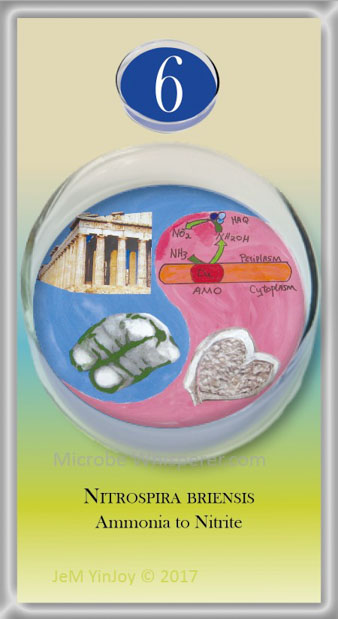
You picked Nitrospira, one of a select group of bacteria that contribute to the Nitrogen Cycle. This is how nitrogen is kept cycling from atmosphere as nitrogen gas, to ammonia and back to nitrogen gas again. The nitrogen cycle is essential to plants in unfertilized soils because in such soils the nitrogen compounds are not available to the plants in any other way. Nitrospira briensis, a tightly coiled being that still remains a mystery to microbiologists. The lessons that Nitrospira teaches you are these: Feigning interdependence for company, Preserving honored history, Enjoyment of a mixed bag of appetites, Contributing more than you get credit for, Tough to pin down to one type of job, or home, Tightly wound, but hides it well.
Nitrobacter Winogradskyi (Nitrobacter Winogradskyi)PETRI
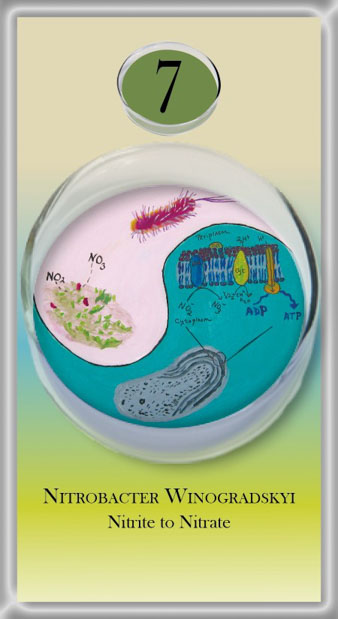
You picked Nitrobacter winogradskyi which was first isolated from rock and soil samples collected in Middle Asia. These bugs form a diverse collection of rod-shaped cells which divide through polar swelling. N. winogradskyi plays an important role in the nitrogen cycle by oxidizing nitrite into nitrate in soil.
Its ability to metabolize both with and without oxygen suggests its first lesson, that of being comfortable with the duality of existence. Shapes are variable, with a pear shape when about to bud a new sister – the variable shapes due to irregular growth and build-up of internal fat storage. The teaching from this microbe is to not be concerned as much with outward appearance as it is to be ready for starvation conditions. N. winogradskyi teaches that you should always be prepared for survival and to do this, develop a lopsided approach.
Streptomyces Coelicolor (Streptomyces Coelicolor)PETRI
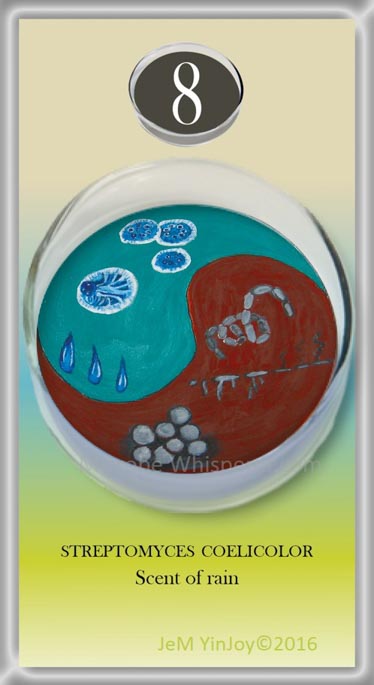
You picked Streptomyces coelicolor, a bacterium that produces a chemical called geosmin, which gives us the “scent of rain.” Streptomyces look like fungi. They develop a vegetative mycelium from a spore, then they shoot up strands called aerial mycelia. These mycelia form deep, rich plush carpets on the ground that accomplish an almost miraculous cleansing of pollutants in the soil! These microbes also ooze jewel-like antibiotic droplets from their colorful mycelial mats. This microbe teaches you about distinctive fragrance, harbinger of rain, disappearance of what is dead and encourages you to elongate and branch out, to grow, and to spread out to take full advantage of your habitat while sporting glamorous garments.
Mariprofundus ferrooxydans (Electron Breather)PETRI
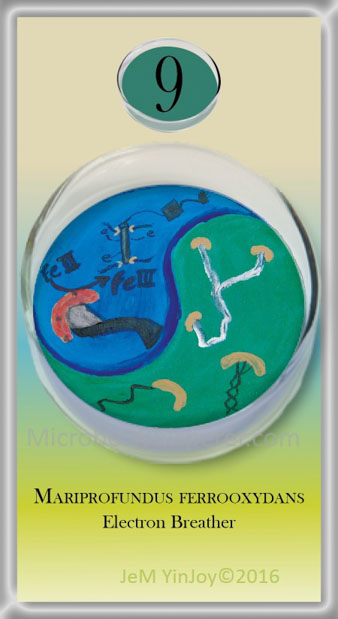
You picked Mariprofundus ferrooxydans, a microbe that can grow by “breathing” electrons. M. ferrooxydans also grows on ferrous iron and it uses two radically different forms to survive on this metal. In the first stage it is motile and moves by flagella, propelling it towards ferrous iron in the microenvironment. Once that niche is tagged for being a source of ferrous iron, the cells are programmed to switch to the second stage, which is when they grow and divide to form new cells. In this second stage, they shed their flagella and enter a new phase, that of stalk formation. During this stage, the stalk is split into a two—pronged fork shape, in which the two cells are attached the ends of each of the split stalk. M. ferrooxydans teaches the spiritual meaning of the letter “Y”, and how to survive on nothing but air and stone by developing a dual existence.
Delftia acidovorans (Gold bacteria)PETRI
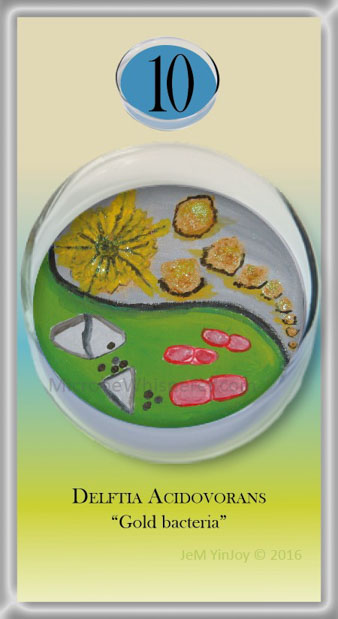
You picked Delftia acidovorans, which is a bacterium frequently found on the surface of tiny gold nuggets, leading microbiologists to discover that it was creating the particles from soluble gold – ions of gold that are dissolved in water. Since soluble gold is toxic, a molecule excreted by the microbe both protects the organism and transforms the toxic ions into particles. This tiny King Midas, teaches you the luxury of sleeping on golden beds and swimming in a golden sea. But this microbe teacher does it by removing gold from its body, as a toxin. By freeing itself from the desire for gold, by protecting itself from this symbol of wealth, the microbe teaches that when greed is abandoned, the side effect is that of unexpected and resplendent abundance.
Serratia marcesans (Blood Red Droplets)PETRI
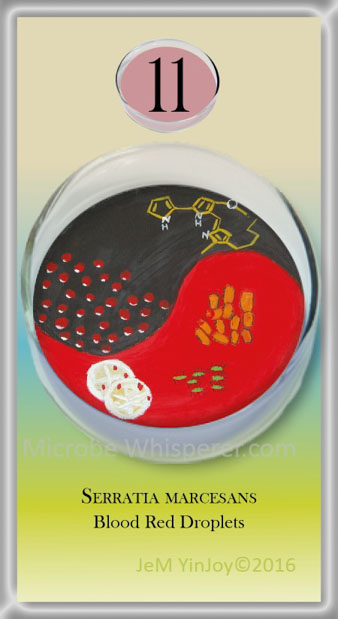
You picked Serratia marcesans, a microbe with an Italian name, it has an Italian notoriety in that it has been depicted by Rafael on the walls of the Vatican in a famous painting. Because S. marcesans is commonly found growing on bread and communion wafers stored in moist places, microbiologists have speculated that this might be the basis for the miracle believed by Catholics, that of transubstantiation. Italian artist Raphael created a work of art called “The Mass at Bolsena”, which shows that during the consecration of the Eucharist, the priest miraculously saw blood dripping from the Host. The story recounts that the priest was skeptical of this miracle, until he was confronted with this red, dripping proof while he said Mass. The actual function of the red pigment is unknown, but given the story of The Mass at Bolsena, who is to say if this is not a divine signal for strengthening the faith of our religious leaders who falter? This compelling microbe teaches you to strengthen your faith in miracles.
Stella Vacuolata (Star Bacteria)PIPETTES

You picked Stella vacuolata a bacterium in the shape of a six-pointed star, a very familiar design that has been adopted by many world religions. In Judaism, it is “the Star of David,” in Hinduism it is the Anhata, and in paganism it is the combination of the Shakti with the triangular part pointed to the earth, and the Shiva, with the triangular part pointed to heaven. The triangle pointing down in the six-pointed star, represents the Earth and the feminine, and the triangle pointing up represents the heavens or the masculine. The fusion of the two triangles denotes the union of male and female, or of heaven and earth. This microbe uses internal bubbles to move up and down a water column to find food. Stella appears to you today to teach this: Blow bubbles to feed yourself, stay buoyant during emotional turmoil, shape shift towards ancient wisdom, and accept the mysteries above and below.
Bdellovibrio bacteriovorus (Smart Predator)PIPETTES
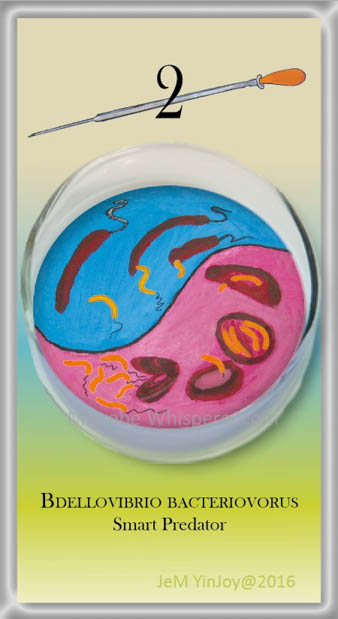
You picked Bdellovibrio bacteriovorus, which in Latin means “Devours bacteria.” As predator and a parasite, this microbe in action is fascinating to watch: from the moment it slams into its prey, and bores into it, and lurks within the bacterial host’s periplasmic space, multiplying daughter cells until it’s ready to “birth” its progeny. When this “birth” happens, the host cell is destroyed in a dramatic and devastating event, but the new Bdellovibrio daughter cells that emerge are lively with the energy taken from its host. B. bacteriovorus teaches you to exploit the hidden areas of an environment, finding spaces no one else thought were habitable, converting environment for selfish purpose, giving birth to progeny by using others’ resources, and the destruction of the past to multiply opportunities.
Polaromonas vacuolata (Psychrophilic)PIPETTES
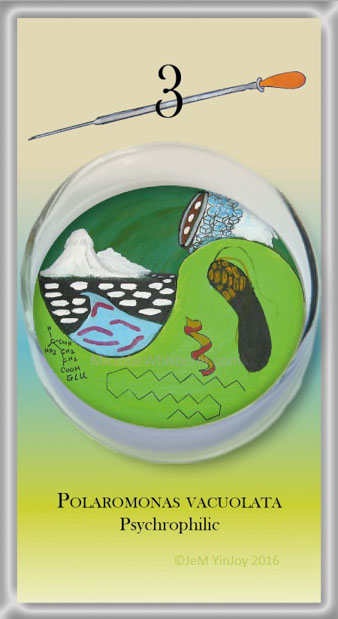
You picked Polaromonas vacuolata, a bacterium that thrives in freezing temperatures. Icy marine shelves, snowflakes and snow so cold it is blue, create a cozy home for this microbial ice princess. And just as befitting glacial royalty, P. vacuolata is well equipped with its personalized protective accessories for staying fluid and active for a comfortable residence within the frozen environs of the Antarctic waters. With special molecules as its parka, thermal wear and boots, P. vacuolata is encapsulated and encases all the right stuff to withstand the rigors of living within a permanently frosty liquid. P. vacoulata teaches us to have systems in place in our lives, not just for surviving a habitat, but for always being equipped with the right outfit for total immersion. P. vacuolata also teaches that emotions are easier to deal with when the temperature is turned way down – that is, when the hectic knocking about of molecules in liquid water, slows down long enough to freeze, and create a wonderfully ordered crystal lattice of water molecules with plenty of open space.
Corynebacterium (Club-shaped Bacteria)PIPETTES
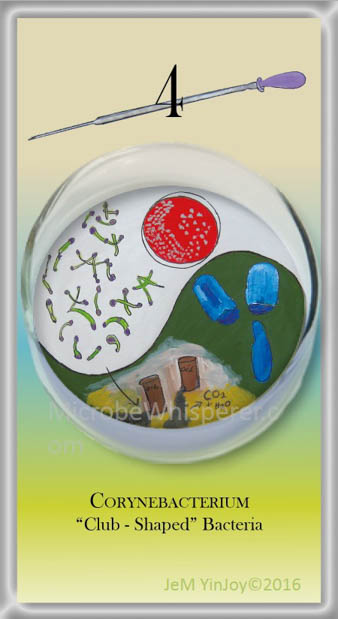
You picked Corynebacteria. These bacteria snap off when they divide, unlike their counterparts that bud off in a steady conservative manner. This “snap” of rebellion leaves tracks however, and in this case, a scatter of “letters” that are described as “Chinese characters.” These microbes also have a club-like appearance under the microscope, and “V” shapes too.
In fact, the unusual shapes of this microbe are reminiscent of the forms of divination that involve the throwing of bones or sticks on the ground. Throwing the bones is an ancient form of divination practiced in Africa, Asia and North America, where the seer uses bones of an animal mixed with other natural elements such as stones, or animal teeth, and predictions are made based on the pattern that emerges from the scatter of bones. Corynebacteria appeared to you today to teach you about reproducing your dreams rebelliously, to be aware of ancient divination tools and to realize messages you receive will be encoded.
Cyanophage (Blue-green Bacterial Virus)PIPETTES
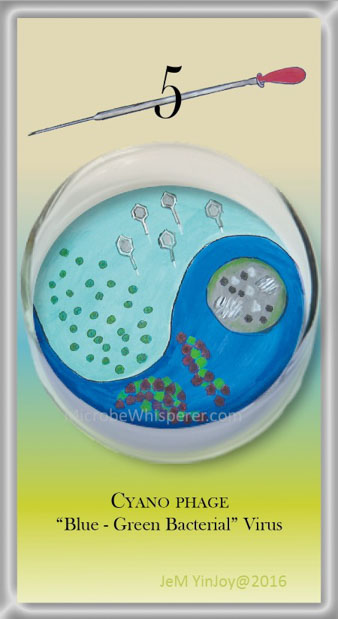
You picked cyanophages, which are viruses that infect a particular type of bacterium which is known by the popular and inaccurate designation of “blue-green algae.” Because cyanobacteria are known to have existed on earth 3 billion years ago (when they oxygenated the anaerobic primordial earth), it is suspected that the cyanophages too must’ve been around with their host cells. The cyanophage’s entire body is to inject and infect a host, solely for the purpose of appropriating all of the resources it doesn’t have for itself. Its construction is geometric, elegant, functional, and deadly to its host. It’s a minimalist when it comes to genetic material too, packing with it only the genes that the host cell will not have, such as the genes for infection, and commandeering the genes on the host cell for most of its reproductive needs.
We are susceptible to toxic cyanobacteria that might affect our fresh water and sea food. So cyanophages are really our helpful medicine guides, as they are imminently our tiny defenders from the “blue-green algae” that can harm us. The cyanophage medicine guide teaches two sides of survival in the wild – by being either the victim, like their “blue-green algae” targets, or the protected ones, that would be us!
Magnetospirillum magnetotacticum (Magnetotactic Bacteria)PIPETTES

Magnetospirillum magnetotacticum is a spiral-shaped microbe with magnetic powers. M. magnetotacticum contains magnetite crystals in an organelles called magnetosomes. The magnetosomes look like beads on a string along the linear axis of the cell. They function as a compass for the cell, to allow it to efficiently detect and migrate along the Earth’s geomagnetic gradient. This movement towards a magnetic pole is called magnetotaxis and microbiologists hypothesize that magnetotaxis allows the microbes to orient themselves an environment with their optimum requirements. M. magnetotacticum is not the only organism that houses ferromagnetic crystals inside its body. In fact, humans have a bit of ferromagnetic inside their noses. It is curious that the expression “follow your nose” is used to advise someone to choose the right direction to go! Maybe the ancients knew of our ferromagnetite crystals that would help us follow true north, which is also what this microbe is teaching: follow your true north.
Rhodocista centenaria (Phototactic Bacteria)PIPETTES

You picked Rhodocista centenaria, phototrophic -bacterium that uses phototaxis to move towards light. R. centenaria is a bit of a secret rebel, and doing things just a tad differently than her relatives. And just when everyone thinks they have her all figured out, she brings out another trick, like the fact that she alone of all her cousins can make her photosynthetic pigments in the dark and she can whisk out sensuous feelers to track the light, the light that is the source of her food when oxygen is sparse.
Being able to know what she needs, when conditions change, is one of her teachings. But on top of that, rather than bemoan the loss of the things that she needs, when a situation changes for the worse, she does not despair or ask for handouts, Instead, she finds it in herself to create the tools to make her own bridges to walk on, or builds a boat, car or train even, if she has to, in order to reach the conditions that are right for her needs. And she is not afraid of how her outward appearance must be altered, if necessary, or any transformation she must undergo, to reach these goals.
Fearless about radical transformation, resourceful when life changes, and willing to get on the next ship to a better life. This is the teaching of R. centenaria.
White Rot Fungi (Multiple Pollutant Degrader)PIPETTES
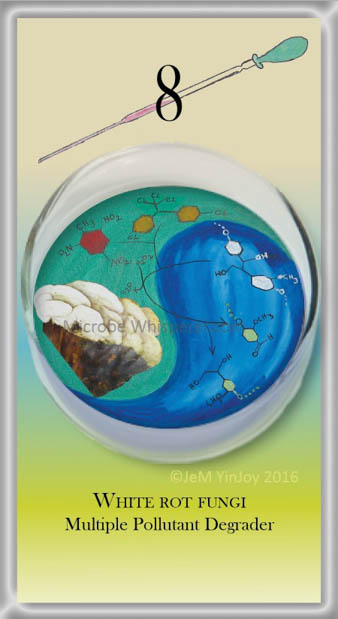
You picked Phanerochaete chrysosporium, a white rot fungus. It has a specialized ability to degrade the plant polymer called lignin. Phanerochaete chrysosporium releases extracellular enzymes (these are enzymes that ooze outside of itself). These enzymes break-up the complex lignin into components that can readily be digested by its unique metabolism. As a positive side effect, these enzymes also degrade PCBs. P. chrysosporium forms a white cobweb after it invades a dead or dying tree, and basically breaks down woody plant material by salivating on it. P. chrysosporium is very beautiful when looked at closely, with strings of hyphae gracefully draping themselves over their next meal. We feed on dead animals, and dead plants. So as consumers of flora and fauna, we have the same MO (modus operandus) as the P. chrysosporium does, except we keep our saliva hidden in our mouths.
The teaching of P. chrysosporium is this – Do not cast aspersions on others as you yourself may be guilty of the acts you are judging so harshly.
And, make sure when you develop a powerful talent or achieve a powerful position, that you are generous to your community and wield that power where it does the most good.
Clostridium Thermocellum (Cellulose to Ethanol)PIPETTES
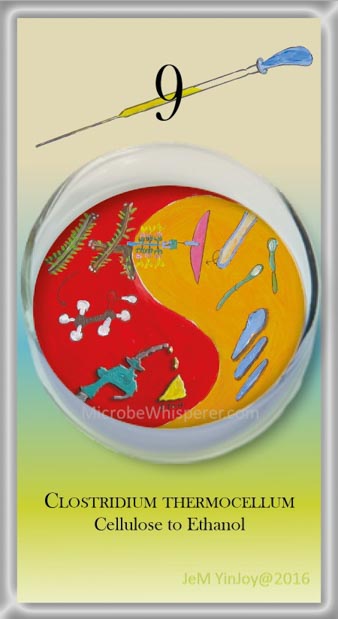
You picked C. thermocellum, a microbe that can break down cellulose from plants to produce ethanol, an alternate fuel. C. thermocellum is best known for its ability to degrade cellulose which is supposedly an extremely insoluble compound. However, to accomplish this feat, C. thermocellum commandeers a collection of enzymes that are part of a large, complex cellulase system known as the cellulosome. C. themocellum teaches that the impossible dream can be accomplished by amassing a community, a state, a federal government, a country and even the world, to make the impossible, a reality.
PCB-Degrading Consortium (Microbial Community at Work)PIPETTES
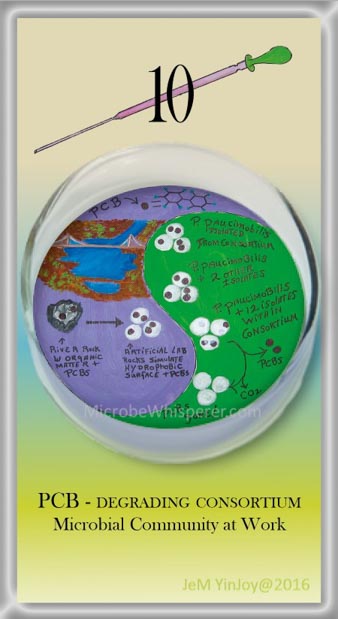
You picked the PCB-degrading consortium. Based on JeM YinJoy’s research, this microbial community showed that PCBs can be degraded while sorbed to the organic layers of the rock surface, and that the PCBs did not have to be in solution to be mineralized by the microbes. Not one single microbe could accomplish this deed. It takes a community, a consortium of microbes to complete the transformation of PCBs to harmless water and carbon dioxide. When JeM’s research was in jeopardy, a shamanic solution saved it and the important contribution to removing PCBs from the Hudson River. The teaching of this microbial consortium is: as a member of a consortium you cleanse rivers, do not ignore the spiritual approach to science, and sacred songs will awaken the sleeping microbe-beast.
Nostoc Verrucosum (Blue-Green Algae)PIPETTES
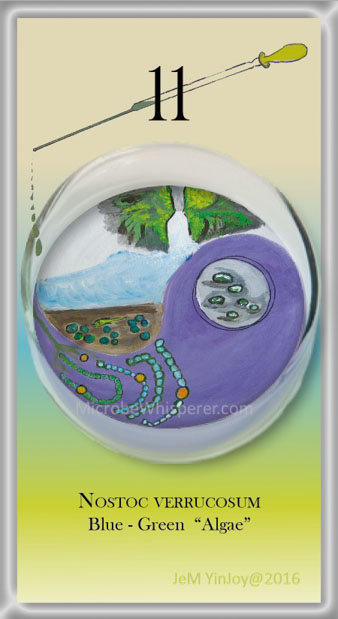
You picked N. verrucosum, a cyanobacterium that grows in creek beds, shallow streams, waterfalls, and moist understory in rain forests. The colonies of N. verrucosum are velvety in texture and they grow in a mass of globules the size of marbles. N. verrucosum is a water-lover, and finds waterfalls particularly attractive.
N. verrucosum is one of the few types of bacteria that creates visible masses of itself. And it has the reputation for being associated with the mystical realms for the fact that it emerges from its microscopic invisibility, as a blooming macroscopic mass of gelatinous “globes” after a rainfall. N. verrocusum has three faces of itself so to speak. (1) The vegetative cell, (2) the hormogonium, and (3) the heterocyst, which houses the powerful enzyme that breaks the triple bond between two nitrogen atoms in nitrogen gas, providing soil and plants with consumable nitrogen. This triple-faced microorganism, with the power to break a triple bond, honors the Feminine Divine by representing the traditional three faces of the goddess: Maiden, Mother and Crone. N. verrocosum, a cyanobacterium, photosynthesizes. As a teacher and medicine guide, this cyanobacterium teaches the power of light, becoming empowered by light, and supporting the earth with crucial nutrients (nitrogen).
Recombinant phototrophs (H2 gas-producing bacteria)LOOPS
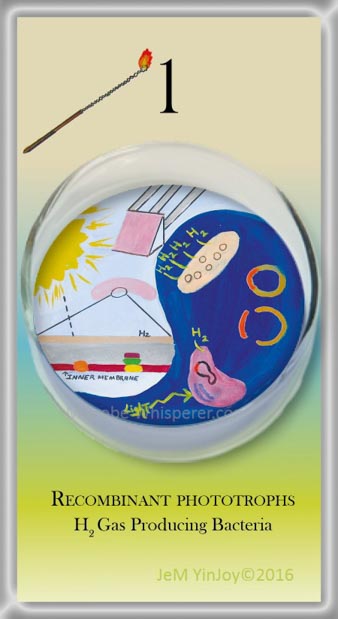
You picked recombinant, photosynthetic microbes that can generate hydrogen gas. The recombinant photoautotroph evokes mythological creatures, like the chimera, because it uses DNA that has been introduced into it artificially. It is a chimera – a composite of other creatures because it not only expresses the genes it was born with, but also, that of another species, another microbe that, if not for the deft interference of a microbiologist, would not have existed in that unnatural state. This complete adoption of another’s genetic make-up, is one of ultimate altruism. It requires a nature that is accepting and tolerant of differences not external to it, but differences that have taken hold of its entire physiology and external presentation to the world. This type of existence, with the expression of another’s genetic code as an additional responsibility, is one of utter surrender to “the other. The spiritual teaching of the recombinant phototroph is this – Surrender to bringing closest to you, those who can benefit most from the light, no matter how foreign they may seem. As you give them light, they in turn can contribute in unexpected ways. For the recombinant phototroph, that way is to make more hydrogen gas, which gives us the ability to make fuel from the sun.
Photobacterium leiognathi (Bioluminescent Bacteria)LOOPS
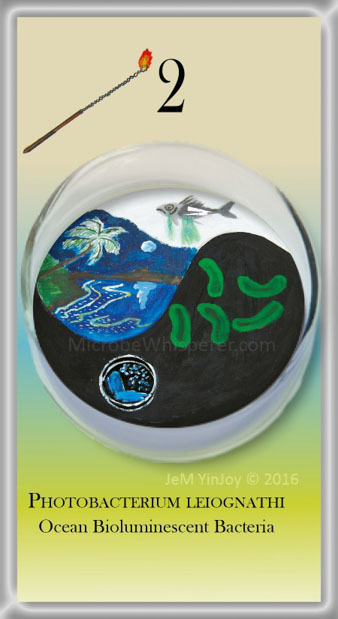
You picked Photobacterium leiognathi, which are bacteria that produce bioluminescence in the oceans, and that live within some types of fish, giving them the ability to use them as biological “flash-lights.” The spiritual lessons taught by P. Leiognathi literally shine through with its light producing nature and its cooperative lifestyle. P. leiognathi is the matchmaker of microbial symbionts because in exchange for its security and nutrients it makes the light that allows the host fish to communicate with potential mates by winking and blinking its special bladder. This microbial teacher advises you to produce light in the dark, know how to live cooperatively with others (mutualistic with its host), work with your peer group to produce something you cannot do alone and resourcefulness.
Desulfovibrio vulgaris (Oil-Drill Corrosion)LOOPS
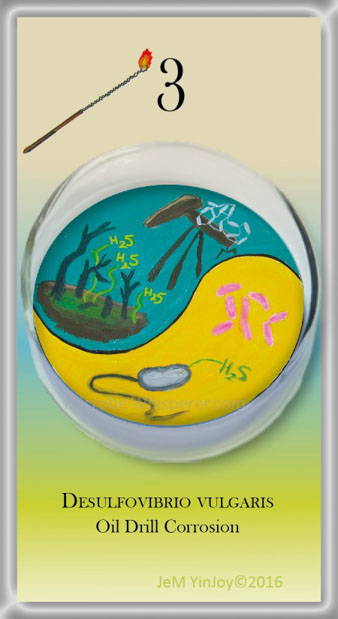
You picked D. vulgaris, a sulfate-reducing bacterium that can eat some metals. The side-effect of their feeding leads to bio-corrosion of metal infrastructure and the bioremediation of toxic metal ions which means turning toxic metals into something harmless. This microbe teaches with its own form of environmental activism. By corroding oil drilling equipment, with its penchant for the tasty metals that are used in these metallic plunderers of Mother Earth, this bacterium teaches you to create your own micro-acts of rebellion to topple the giants.
Azotobacter vinelandii (Free Living Nitrogen Fixer)LOOPS

You picked A. vinelandii, an aerobic, free-living soil microbe, which plays an important role in the nitrogen cycle in nature, transforming nitrogen gas to ammonium ions into the soil. Azotobacter vinelandii is very much a wiccan at heart, with its attention to the power of three when it comes to applying the muscle to rip apart not one or two, but three chemical bonds that bind two nitrogen atoms together. This is no mean feat, as these bonds, created by shared electrons, would put thrice bolted platinum locks to shame. When it is tossed into inhospitable environments, it protects its prize jewels, by pulling out its own little suit of armor, a “tree-bark-like” cyst that allows it to resist most attacks that could suck it dry. This microbe teaches a triple-pronged approach to problem solving and the wisdom of creating a protective coat.
Thermus aquaticus (Taq Polymerase Fame)LOOPS

You picked Thermus aquaticus, a bacterium that thrives within the geysers of Yellowstone. T. aquaticus has benefitted all humanity in as it is the source of the heat-resistant enzyme Taq DNA polymerase, one of the most important enzymes in molecular biology, because of its use in the polymerase chain reaction (PCR) DNA amplification technique which helps find cures for disease and bring criminals to justice. T. aquaticus simply evolved these enzymes to take advantage of its hot, sulfuric microniche. The lesson of T. aquaticus is this – If you land in hot water, make use of your treasures to avoid getting scalded. And, be aware that others may notice your grace under fire and most certainly will pump you for information and the precious possessions that allowed you to endure and thrive.
Methanogens (Methane Producing Bacteria)LOOPS
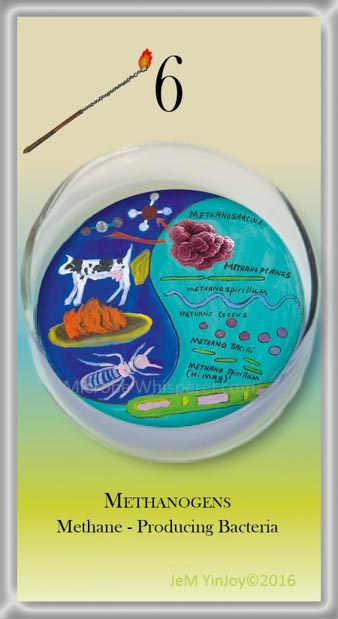
You picked the Methanogens, a group of methane gas making microbes, classified as the ancient microbes in the kingdom Archaea. Oxygen will kill methanogens, so they have evolved to occupy niches in our world and in organisms in our world that are guaranteed to be oxygen-free, such as cow rumen, the hindgut of the termite, sewage digesters, and swamps. This methane gas is responsible for the globally popular legend of the Will-o-the-wisps, the spirits could not enter either heaven or hell, and played malevolent tricks on people.
Will-o’-the-Wisps are caused by burning gases—called “swamp gas,” and methanogens are responsible for the production of methane that is mixed into this swamp gas. Considering their microscopic size, this type of major influence on human civilization is pretty grand.
Of course all microbes extend much influence on our planet, biochemically, and physiologically, but few non-pathogens have entered the annuals of human history in this way, as muses to the authors of these amazing tales. The wisdom of this microbial teacher is this – What you might consider a useless waste product could provide light for millions, so always recycle.
And, don’t underestimate the power of human imagination when it comes to what you keep hidden in the dark.
Vibrio harveyi (Milky Seas)LOOPS
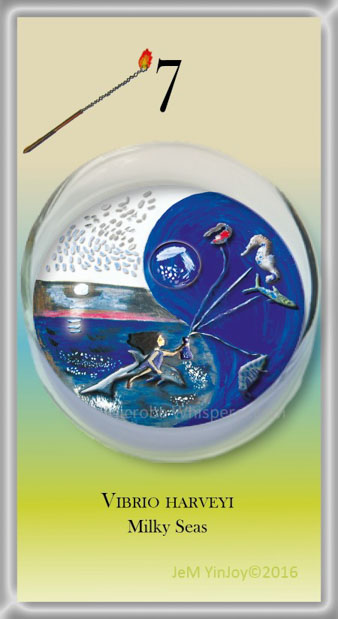
You picked V. harveyi, a natural inhabitant of seawater, which is known for its bioluminescence that creates the appearance of “Milky seas.” V. harveyi creates a “glow in the dark” effect in the sea creatures it inhabits. But unlike related bioluminescent Vibrio genera, V. harveyi is not in kindly symbiosis with sea creatures it invades. V. harveyi sickens its hosts and kills them. The difference between V. harveyi and its kindly close cousin, could be a matter of a few stretches of genes on its genome. Microbiologists are busily getting the entire genome of V. harveyi translated to figure out how to use its talents for good. The lesson of V. harveyi is this: Do not get seduced by a beautiful fake.
Pyrolobus fumarii (Extreme Heat Bacteria)LOOPS
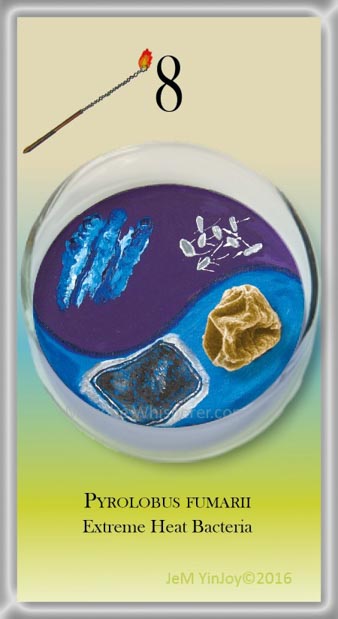
You picked Pyrolobus fumarii, an extreme hyperthermophile – meaning it grows at fiery hot temperatures that would sear other organisms to death. P. fumarii is suspected of having had its origins in ancient Earth’s roiling, and lightening heated primordial soup, back when earth was not even oxygenated. Later when the earth cooled, P. fumarii found solace in the last remaining niches on the planet that provided the high temperatures and nutrients they would need to survive. The biological equipment that endow P. fumarii with its talent to endure superheated water is not completely understood. P. fumarii teaches you like a hot, passionate, and very experienced temptress. This microbial guide protects the secrets to her allure, and suggests that you do the same, because you might be related to extraterrestrals.
Compost Microbes (Natural Waste Disposers)LOOPS

You picked compost microbes, which live in a compost pile. By creating our own compost piles, we become alcolytes of Mother Earth, learning from her own digestive processes to use the natural microflora within her gut, to convert discarded plants, vegetables, flowers, tea leaves etc…, into rich, fertile soil for future planting and harvesting of more food. This alchemical processing by the microbial community within the compost pile, converts kitchen garbage and other waste of our daily lives, into deep rich earth “gold”. The type of earth that nourishes seeds for tomatoes, peppers, onions, garlic, roses, grapes, apple trees and…you get the picture. This cornucopia is made possible by the joint activities of many microbes.
The wisdom of the composting microbes is this:
Work tirelessly to give to your community, as the fruits of your labors are limitless. And, make sure when you die, you have created a nourishing environment for your successors.
Vibrio fischerii (Bioluminscent & Symbiotic)LOOPS
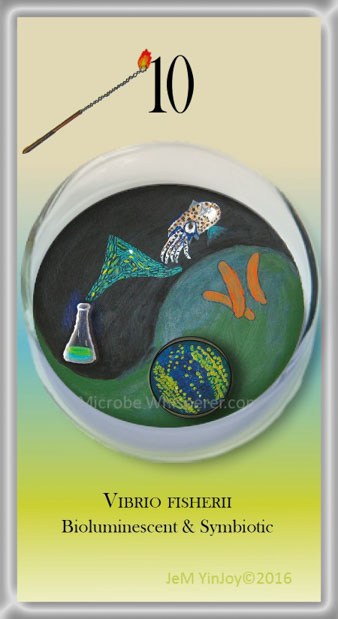
You picked Vibrio fisherii, which is a both free-living and mutualistic microbe, having evolved an association with various species of fish and squid, to benefit both the host and the microbe. Among the millions of bacteria swirling in the warm Hawaiian waters of the baby bobtail squid, only V. fisherii is the chosen one, with the ideal gears and tethers on its microscopic body that align perfectly with the internal special organs of the squid, a place V. fisherii calls “home.” Now the squid secretes juices that signal to the bioluminescent microbe when it is time to gleam and dim. And so this little sea creature lives in a harmonious synchrony with the guest microbes, that make its belly glow. In this way, the bobtail squid keeps itself hidden from would-be predators, with its built-in microbial flashlight, to hide by the light of the moon. This microbe teaches you: the art of forming physical intimacy, protecting those who feed and house us, and finding the ideal home.
Deinoccocus (Hardy Bacteria)LOOPS
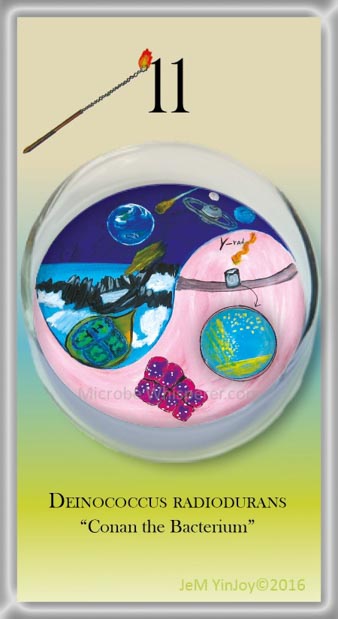
You picked D. radiodurans, one of the hardiest bacteria known. Because of this reputation, it has been dubbed “Conan the Bacterium.” Like the strong and muscular barbarian from this movie reference, D. radiodurans has the power to endure extremes of heat and cold, strong acids ultraviolet light, desiccation, ionizing radiation and even, the vacuum of space! The unusual array of talents hoisted around D. radiodurans’ belt, has caused microbiologists to wonder if D. radiodurans originated from a far distant galaxy, brought to us by a meteorite. That story already has the stamp of superhero legend on it, doesn’t it? One superpower that D. radiodurans is teaching you about, is that of a being a powerful healer. Just as Christopher Reeves embodied the essence of super hero and healer, after going from Super Man to a paraplegic survivor and spokesperson, D. radiodurans teaches you to recognize the essence of these dichotomies within yourself.
Disclaimer – Microbe Whisperer is not responsible for the actions you may take as a result of the online readings you receive. While the readings can provide spiritual insight and guidance, please know that they are subject to interpretation. If you are experiencing imbalances such as confusion, high stress, or depression, you are urged to seek professional help.








